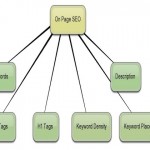1. Use keywords throughout your web site
Many people do a good job putting a good description and group of keywords in their meta tags, but they do not use these same keywords throughout the rest of their web site. You must continue to use your keywords throughout the content on the rest of your web site if you would like to get high search engine rankings.
2. Create a sitemap
Many search engines will try to index your site’s pages by following links to all of the different pages. However if a search engine is unable to follow a link, then a page might not get included in the search engine’s results. To make sure all of your pages get indexed, make sure that you have a text-based sitemap that includes all of the major pages of your web site. Also create an xlm sitemap that should be submitted to search engines.
3. Use Flash sparingly
Flash is a very neat technology and it has its place on the web. However you do not want to overuse Flash, because a search engine will not be able to read the text that is embedded in the Flash elements, which could hurt your ranking if you have keywords in that area.
4. Get inbound links
One of the best things that you can do for search engine optimization is to get inbound links to your web site. If you are able to get high quality web sites that relate to your business to link to your web site, then your search engine ranking is sure to climb. Keep in mind, spam linking willl not do you any good!
5. Domain Name
Your domain name should be brandable (example: Google, Amazon, Yahoo!, etc.), easy to say, and even easier to remember. Don’t worry too much about stuffing keywords into your domain name. Keywords in domain names no longer have the punch they used to.
6. www or not www
The choice is yours, http://www.EmpireMedia.com/ or http://EmpireMedia.com/, pick one and stick with it.
7. Simple Design
Don’t reinvent the wheel. If your design is complex, chances are it will hinder your visitors’ ability to navigate and view the site plus it will slow down development. The simpler the better.
8. Don’t create directories further than three levels down from the root directory
The closer pages are to the home page in the directory structure the better. Keep things organized but don’t over-organize. If you have one file or sub-directory in a directory there should be a VERY valid reason.
9. File/Directory Names Using Keywords
Your filenames and directory names should contain keywords. If your page is about Idaho potatoes then the file-name should be idaho-potatoes.
10. URLs
Static URLs are URLs that are not dynamically generated. A static URL looks like http://www.empiremedia.com/file-name.html and dynamic URLs look like http://www.empiremedia.com/tag/jquery/. You can make dynamic URLs spiderable by search engines but it’s a lot easier to get things indexed with static URLs.
11. Think Small
The smaller your Web pages are, the faster they load. A single page should be less than 15K (unless absolutely necessary) and the entire page including graphics should be less than 50K (unless absolutely necessary). Remember, not everyone is on a high-speed Internet connection; there are still people without a 56K modem.
12. Hyphens
Use hyphens ( – ) and not underscores ( _ ) to separate words in directory and file names. Most search engines parse a hyphen like a reader would parse a space. Using underscores makes what_would_you_do look like whatwouldyoudo to most search engines. You should definitely separate words in your URLs
13. Navigation on Every Page
You should place consistent navigation on every page of your Web site. Your navigation should link to the major sections of your Web site. It would also make sense for every page on your Web site to link back to the home page.
14. Title
The title of the page should be used in the TITLE tag and at the top of every page. The title should be keyword rich (containing a max of 7 to 10 words) and descriptive.
15. Description META Tag
Some people say META tags are dead but some search engines will actually use them underneath a pages title on search engine result pages (SERPs). Use no more than 150 characters including spaces and punctuation. Your description should be a keyword rich, complete sentence.
16. Keyword META Tag
A listing of keywords that appear in the page. Use a space to separate keywords (not a comma). Arrange keywords how they would be searched for or as close to a complete sentence as possible. This tag is basically dead but by creating it when you create the page it allows you to come back eons later and realize what keywords you were specifically targetting. If the keyword doesn’t appear at least twice in the page then it shouldn’t go in the Keyword META Tag. Also, try to limit the number of total keywords to under twenty.
17. Robots META Tag
Some search engine crawlers abide by the Robots META Tag. This gives you some control over what appears in a search engine and what doesn’t. This isn’t an essential aspect of search engine optimization but it doesn’t hurt to add it in.
18. Heading Tags
Heading tags should be used wherever possible and should be structured appropriately (H1, H2, H3, H4, H5, H6). You shouldn’t start a page with an H2 tag. If H1 by default is too big then use CSS to style it effectively. Remember that most search engines like to see a heading tag then text or graphics; not H1 followed immediately by H2.
19. TITLE Attribute
Use the A HREF TITLE attribute (example: <a href=”page.html” title=”This page contains links to other pages.”>). The TITLE attribute improves usability/accessibility. Be sure to include keywords as you see fit but remember it should tell your visitors where they will go when they click the link.
20. ALT Tags
Every image should have an ALT tag. Use a keyword rich description of what the image is. If the image contains text use the text in the image. This is also a usability/accessibility tool.
21. More text than HTML
A page should have more text content than markup language.
22. Anchor Text
Anchor text is the text used to link to a page. Using keywords in anchor text is a very good idea and will improve a page’s performance in SERPs.
23. Use Text Links, Not Images
If you’re going to link to something use text. Text in images can’t be read by search engines. The only time this rule doesn’t apply is when you’re linking to something with a well known logo. Even then it’s still better to use a text link. If you must use an image as a link then make sure you give it a good ALT tag
24. Content, Content, Content
The more content, the better. Having pages upon pages of original, relevant content is the best form of search engine optimization.
25. Add New Content Often
If you can add a new page of content every day then your site will stay fresh and give search engine crawlers a reason to keep coming back day in and day out.
26. Keyword Density
This is a touchy topic among Web developers and search engine optimizers. Some say 5% is more than enough. Chris Short says your main keywords shouldn’t have a density of more than 30% and should be higher than the densities of other phrases and words.
27. Build It, Put It Online
Your site should be built and in “update mode” once it’s uploaded to your Web server. Don’t add a page at a time to your Web server when you’re first building your Web site. Build your Web site first then upload it. Add new content as needed.
28. Use a robots.txt File
Every good crawler looks for a robots.txt file in your root directory. I would highly recommend creating a valid robots.txt just to appease these search engines and at the very least eliminate 404 errors from building up in your log files.
29. Validation
Every page on your Web site should adhere to W3C standards as closely as possible. Some say page validation can help your ranking in SERPs (the jury is still out on that one). But, standards compliant Web pages do help with cross browser compatibility.
30. Link Popularity
Once your Web site has been well established, it’s time to build up your link popularity. The more relevant inbound links a Web site has, the better its rankings will be.
31. Analyze Traffic
Read your log files often. Make sure you’re not getting traffic you don’t want and getting traffic you do want. Keeping a pulse on your traffic allows you to better optimize your pages.
32. No tricks
If it doesn’t seem ethical, then it isn’t a good idea. If it doesn’t help your visitors, then don’t do it.
33. No frames
Don’t use frames, ever.
34. No broken links
Linking to pages that don’t exist is a very bad thing. Search engines and people alike hate that.




